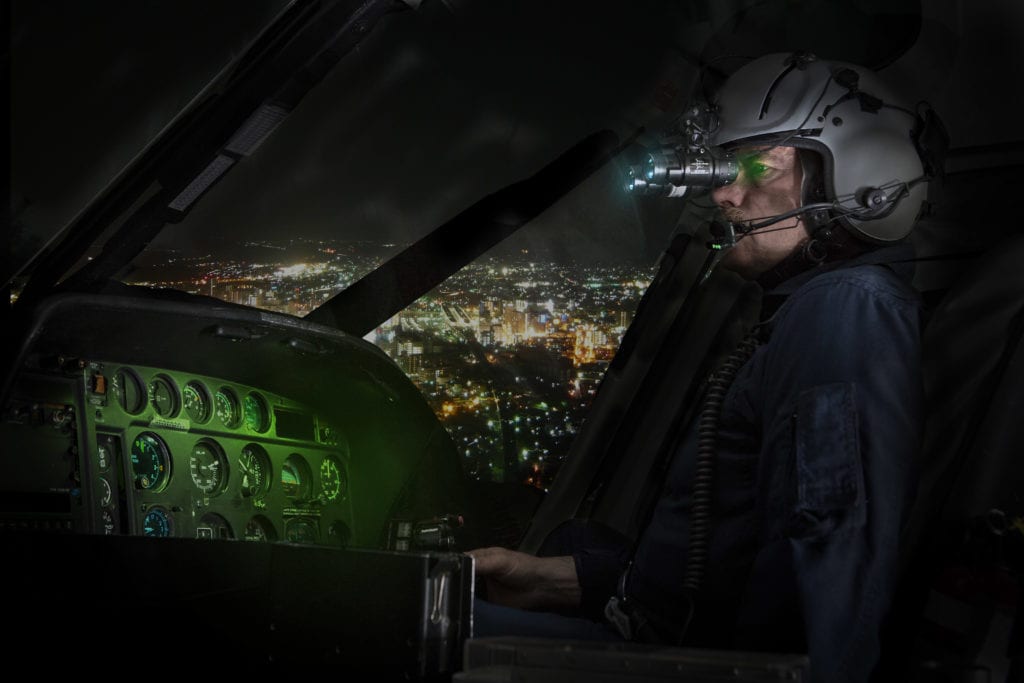
An Air Methods pilot using night vision technology. Air Methods is one of several companies joining the UHSHT in its efforts to highlight avionics recommendations to helicopter operators. Photo: Air Methods.
Avionics improvements are a part of the U.S. Helicopter Safety Team’s (USHST) efforts to reduce the number of fatal rotorcraft accidents.
On Sept. 3, USHST released a list of 16 proposed safety enhancements for helicopters under five headings: visibility and loss of control; risk management; enhanced training; technology support; and pilot competency.
Among the organizations participating in USHST helicopter safety discussions are Air Methods, Bell Helicopter, Boeing, the Dallas Police Department, Embry-Riddle Aeronautical University, the Federal Aviation Administration, the General Aviation Manufacturers Association, Helicopter Association International, the Helicopter Safety Alliance, L3Harris, Life Flight of Maine, Lockheed Martin’s Sikorsky, the MITRE Corp., the National Transportation Safety Board, Prism Helicopters, and Robinson Helicopters.
The technology support efforts include encouraging industry to develop and install stability augmentation systems (SAS) and/or simple autopilots in light helicopters; promoting the installation and use of data recording devices, for example helicopter flight data monitoring (HFDM) recorders and camera recorders to detect and monitor aircraft and engine limitations that were exceeded. USHST is also promoting the use of enhanced helicopter vision systems technologies, such as night vision goggles, enhanced vision systems, synthetic vision systems, and combined vision systems, to aid pilots in recognizing and preventing unplanned flight into degraded visibility conditions due to weather and to increase pilot safety during planned flights at night.
Stability augmentation systems were once beyond the financial reach of many private helicopter owners. Last year, however, Kurt Robinson, the CEO of Robinson Helicopters, said that pilots and owners can more readily afford an autopilot/stability augmentation system for Robinson models than in previous years when the cost of a SAS roughly equalled the cost of an R22. In addition, there have been recent market innovations.

Elbit Systems’ SkyVis is one of several head-worn technologies that may improve safety in helicopter operations. Photo: Elbit Systems
For example, at the Aircraft Electronics Association 2019 convention in March, Genesys Aerosystems unveiled an instrument flight rules (IFR) version of its HeliSAS autopilot system for legacy Part 29 twin-engine helicopters. Designed for two-axis (pitch and roll) autopilot configuration for dual-pilot IFR operations and three-axis (pitch, roll, and yaw) autopilot configuration for single-pilot operations, the system includes automatic recovery to near-level flight altitude at all airspeeds and full authority control with parallel actuators. Metro Aviation has become the first operator to install and start flying the new system on an Airbus EC-145e.
On the data recorder side, helicopters have been limited in their storage capacity because of the requirement that such recorders be hardened to withstand extreme flight conditions and crashes. But industry has been working over the last decade to provide high-capacity data recorders.
For example, Curtiss-Wright said that its Fortress Flight Data Recorder meets the requirements of EUROCAE Minimum Operating Performance Specification ED-112A, surpasses the requirements of the upcoming 2021 EASA minimum 25-hour cockpit voice recording mandate and includes image recording. Curtiss-Wright said that it furnished Fortress for one helicopter builder that wanted the recorder to meet future requirements, such as the United Kingdom’s Civil Aviation Authority (CAA) specification No. 23. The helicopter builder has also sold units to a jurisdiction that is to introduce new image recording requirements next January as the result of a police helicopter accident in 2013–a crash that resulted in a mandate to outfit helicopters conducting state operations, such as police search-and-rescue, with crash worthy image recording equipment, according to Curtiss-Wright.
For enhanced vision systems, the Elbit Systems-owned Universal Avionics is partnering with the FAA to develop regulations to support the use of such systems to improve rotorcraft flight safety.
Earlier this year, Universal Avionics said that the FAA is mulling the use of the company’s Heli-ClearVision as a representative enhanced helicopter vision system to improve helicopter safety and provide operational benefit during day, night and low-visibility conditions.
The FAA and Universal Avionics have fully integrated testing hardware into the FAA’s Sikorsky S-76 at William J. Hughes Technical Center, and FAA test pilots have conducted training and familiarization flights on the technology.
Further testing is to include the company’s SkyLens and SkyVis technology, capable of displaying primary flight display symbology, conformal information, synthetic vision and an enhanced vision with an EVS-4000 multispectral camera and combined vision system.